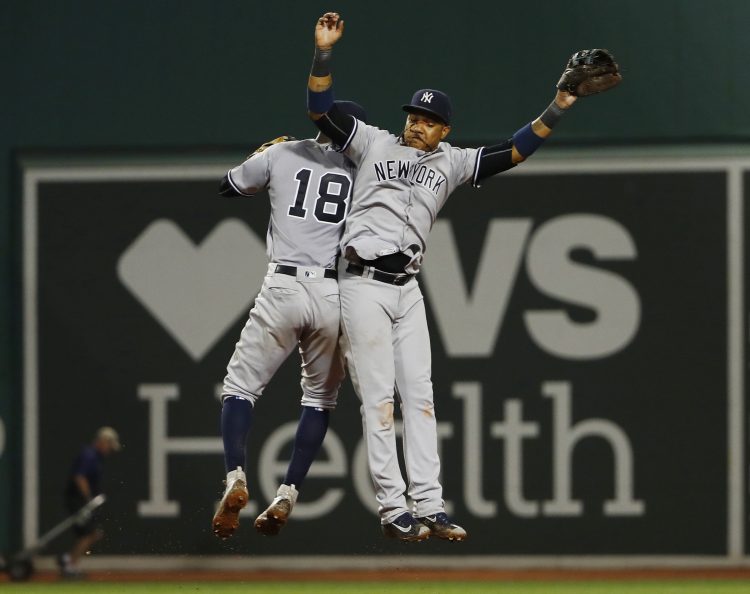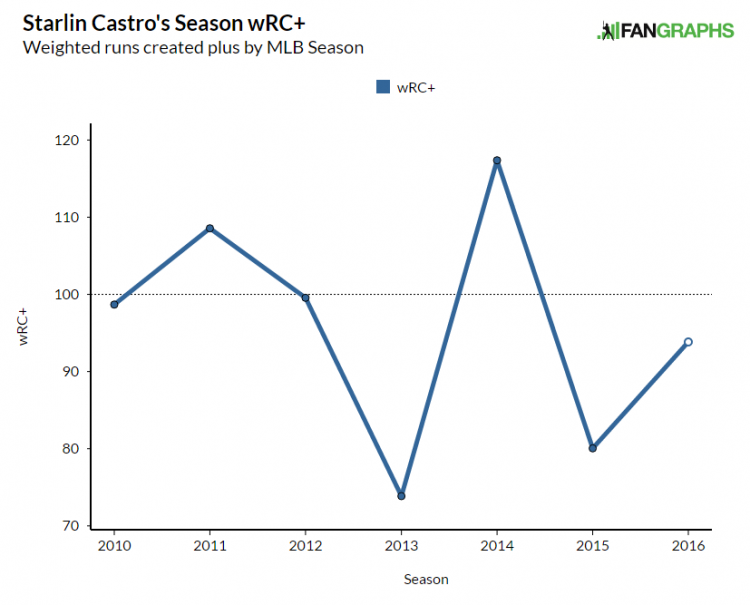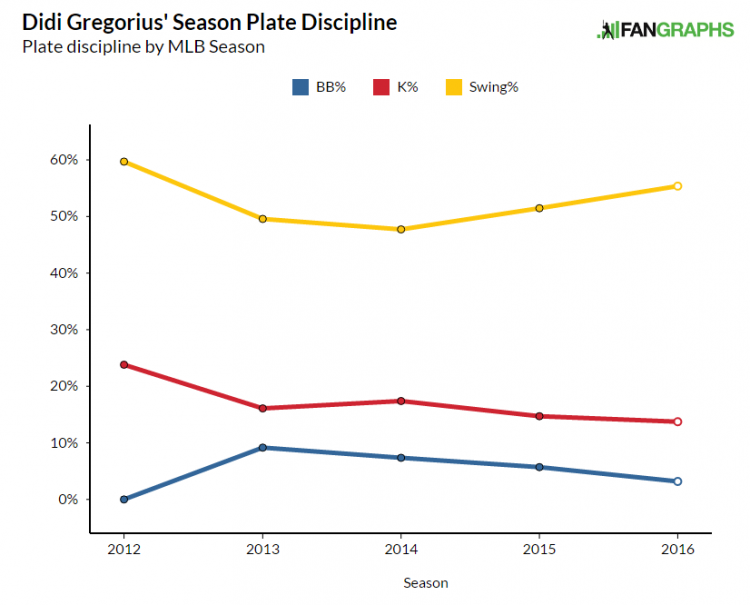
There seems to be a strong consensus that 2016 was a breakout season for Didi Gregorius, and something between a disappointment and a shrug of the shoulders for Starlin Castro. This is unsurprising, considering that the former set career highs (nearly) across the board, whereas the latter failed to have the change of scenery bounceback that many expected – but is it fair? Consider their offensive production last year:

Their numbers were virtually indistinguishable. Gregorius struck out significantly less, to be sure, but it’d be difficult to find two more comparable players otherwise (much less a duo that mans the same middle infield). It feels like cognitive dissonance to an extent.
The comparison shouldn’t end there, of course, as Gregorius was the superior base-runner, adding between four and eight extra runs depending on your metric of choice, and he played the more difficult position (both were subpar defenders by most measures, though the eye and reputation tests tell another story entirely for Gregorius). As a result of these factors, Gregorius had a comfortable lead in both fWAR (2.7 to 1.1) and bWAR (2.2 to 1.2). He was undoubtedly the better player, but the similarities remain striking.
With Gleyber Torres setting the world ablaze, Tyler Wade in Triple-A, and Jorge Mateo still earning some prospect love, the Yankees are certain to be watching the performances of Castro and Gregorius closely. And if they see an opportunity to improve the team with a cheaper, internal option, they might just take it.
So what should be expected of the Yankees current double play combination in 2017?
Starlin Castro
The only real constant in Castro’s career to-date has been his inconsistency. Plotting his year-to-year wRC+ results in a fairly wicked looking roller coaster:

Put that all together and you have a roughly league-average hitter, with a 162 game average of .280/.318/.408 (96 wRC+) and 13 HR. Both ZiPS (.272/.305/.419 with 18 HR) and PECOTA (.268/.308/.415 with 16 HR) project more of the same in 2017, which makes sense at this point in his career. Castro is still quite young, as he won’t be 27 until March 24, but he has 4374 Major League plate appearances under his belt, and he has regressed more so than anything else of late.
Just last week, however, Mike dug into a potential breakout season for Castro, discussing the reasons for optimism, which essentially boil down to past success, harder (and better) contact, greater comfort at the keystone, and his age. In the end, Mike thinks that a .300/.340/.475 line is within the realm of possibility; it’s tough to disagree, given that he hit .307/.341/.432 in 2011 and .292/.339/.438 in 2014, and just showcased the best power of his career last year. I wouldn’t expect that level of production – but it wouldn’t shock me, either.
This does feel like a big year for Castro, at least insofar as his pinstriped career is concerned. He’s no longer cheap, as he’ll earn an average of just under $11 MM over the next three years, but he’s far from untradeable, given his age and ability to play an up-the-middle position. Another middling season might result in him playing elsewhere in 2018, as it’s no secret that he is (or was) available in trade talks this off-season.
Didi Gregorius
Projecting Gregorius’ 2017 is an incredibly difficult task, as the shape of his production has changed dramatically over his four full-ish seasons. Keeping in mind that his 2012 season was a 21 PA cup of coffee, take a look at the following:

In 2013 – his first full-ish season – Gregorius walked in 9.2% of his plate appearances, which was comfortably above the league-average walk rate of 7.9%. He swung a bit more often than the average player by about 4 percentage points, but his strikeout rate was better than average and his 91 wRC+ as a 23-year-old shortstop was more than acceptable.
Fast forward to the end of 2016, and Gregorius looked like a completely different player. His 3.2% walk rate was 5 percentage points below average, his 13.7% strikeout rate was 7.4 percentage points above average, and he swung at 55.4% of pitches thrown his way (the highest among all qualified shortstops, and tied for 6th in the Majors). His gradually developed aggression resulted in the best season of his career.
Much of the discussion about Gregorius’ 2017 revolved around his 20 home runs, which nearly matched his total of 22 in 1302 PA from 2012 through 2015. The most glaring improvement last season, however, came against LHP. Heading into 2016, the Dutch shortstop was a career .214/.282/.272 hitter (52 wRC+) against southpaws, and it seemed as though he may have to be platooned. There were signs of life in 2015, as a 74 wRC+ might just be playable with his defense, but it was still far less than ideal.
And then he hit .324/.361/.473 (126 wRC+) against LHP last year, striking out in just 7.5% of those plate appearances. He also walked in just 2.5% of that 161 PA sample size, posting an uncharacteristic .331 BABIP along the way. It wouldn’t be out of the ordinary for a player to solve same-handed pitchers as he enters his prime, but we need more evidence to prove that he did just that.
Neither ZiPS (.262/.308/.404, 15 HR) nor PECOTA (.259/.309/.400, 14 HR) sees Gregorius repeating his 2016, though both do see him sustaining a bit of his power surge. At the same time, though, projections do not always take into account tangibles changes in approach over a short-term, which may well be the case with the Yankees shortstop.
What about their defense?
In an ideal world, the Yankees middle infield defense would be an embarrassment of riches. Castro was somewhere between a below-average and fringe-average defensive shortstop, and one would expect his tools to play-up as he slides down the defensive spectrum. And Gregorius was a legitimate prospect largely due to his potential Gold Glove defense, and his reputation is still that of a plus defender. If only it were that simple.
By Defensive Runs Saved and UZR/150, 2016 was Castro’s worst defensive season. That shouldn’t come as a surprise, as he had all of 258 innings at second prior to the 2016 calendar year, but there was some sense that his defense backslid as the year wore on. His acclimation to the Bronx and the position may well lead to a sizable step forward in defensive value this year, and that might just be the most important aspect in reviving his overall stock.
And, as I inferred earlier, the advanced metrics cast Gregorius as a middling, if inconsistent defender. He was worth 5 DRS and 7.9 UZR/150 in 2015, but was below-average in both in his other three full-ish seasons. DRS pegged Gregorius as a -9 defender last season, meaning he nearly cost the team a win relative to the position. The truth may well be that he’s merely average, with his smooth actions and strong arm masking his inadequacies to the naked eye. Given the Yankees dedication to defense, you can be sure that they’re watching him closely.
With the exception of the rookies and comparably inexperienced players, I’m not sure that there are two more difficult Yankees to project – and Castro and Gregorius feel somewhat less certain than a few of those guys, as well. If I were to hazard a guess, I’d say that Castro improves a bit overall (owing largely to improvements on defense), Gregorius produces a similar total package (perhaps with a bit less power and a bit more glove) … and we’re regularly reminded that Torres is tearing it up in the minors.
Leave a Reply
You must be logged in to post a comment.